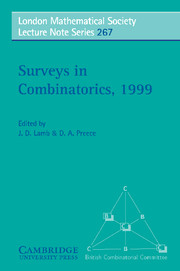Book contents
- Frontmatter
- Contents
- Preface
- The Rado Lecture
- The Invited Lectures
- Polynomials in Finite Geometries
- Applications of Combinatorial Designs to Communications, Cryptography, and Networking
- Random Walks on Combinatorial Objects
- Bose–Burton Type Theorems for Finite Projective, Affine and Polar Spaces
- Geometric Graph Theory
- Recent Excluded Minor Theorems for Graphs
- Parity, Cycle Space, and K4-Subdivisions in Graphs
Random Walks on Combinatorial Objects
Published online by Cambridge University Press: 05 May 2013
- Frontmatter
- Contents
- Preface
- The Rado Lecture
- The Invited Lectures
- Polynomials in Finite Geometries
- Applications of Combinatorial Designs to Communications, Cryptography, and Networking
- Random Walks on Combinatorial Objects
- Bose–Burton Type Theorems for Finite Projective, Affine and Polar Spaces
- Geometric Graph Theory
- Recent Excluded Minor Theorems for Graphs
- Parity, Cycle Space, and K4-Subdivisions in Graphs
Summary
Summary Approximate sampling from combinatorially-defined sets, using the Markov chain Monte Carlo method, is discussed from the perspective of combinatorial algorithms. We also examine the associated problem of discrete integration over such sets. Recent work is reviewed, and we re-examine the underlying formal foundational framework in the light of this. We give a detailed treatment of the coupling technique, a classical method for analysing the convergence rates of Markov chains. The related topic of perfect sampling is examined: in perfect sampling, the goal is to sample exactly from the target set. We conclude with a discussion of negative results in this area: these are results which imply that there are no polynomial time algorithms of a particular type for a particular problem.
Introduction
The focus of this paper is approximate sampling and approximate counting (or approximate integration), using the Markov chain Monte Carlo (MCMC) method, and viewed from the perspective of combinatorial algorithms. There has been much work in this area in recent years, some of which we survey below in Section 4. We illustrate this work with a closer examination of one particular technique which has proved successful recently, that of coupling. This is a classical method from applied probability, but its application in this area has involved some new insights.
Formal foundations for work in this area were provided in the seminal paper of Jerrum, Valiant and Vazirani [50]. However, the subject seems subsequently to have outgrown the framework it provided. The present paper makes a modest attempt to update the situation.
- Type
- Chapter
- Information
- Surveys in Combinatorics, 1999 , pp. 101 - 136Publisher: Cambridge University PressPrint publication year: 1999
- 31
- Cited by

